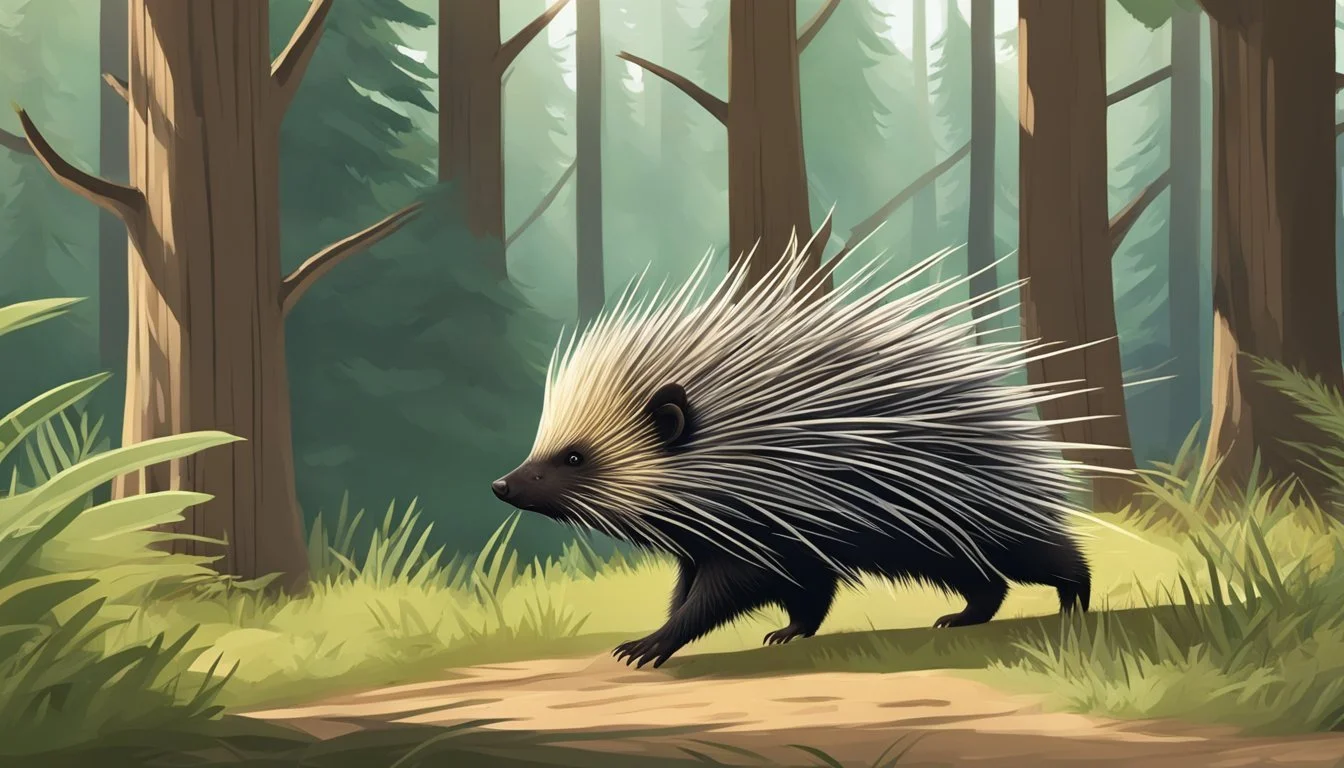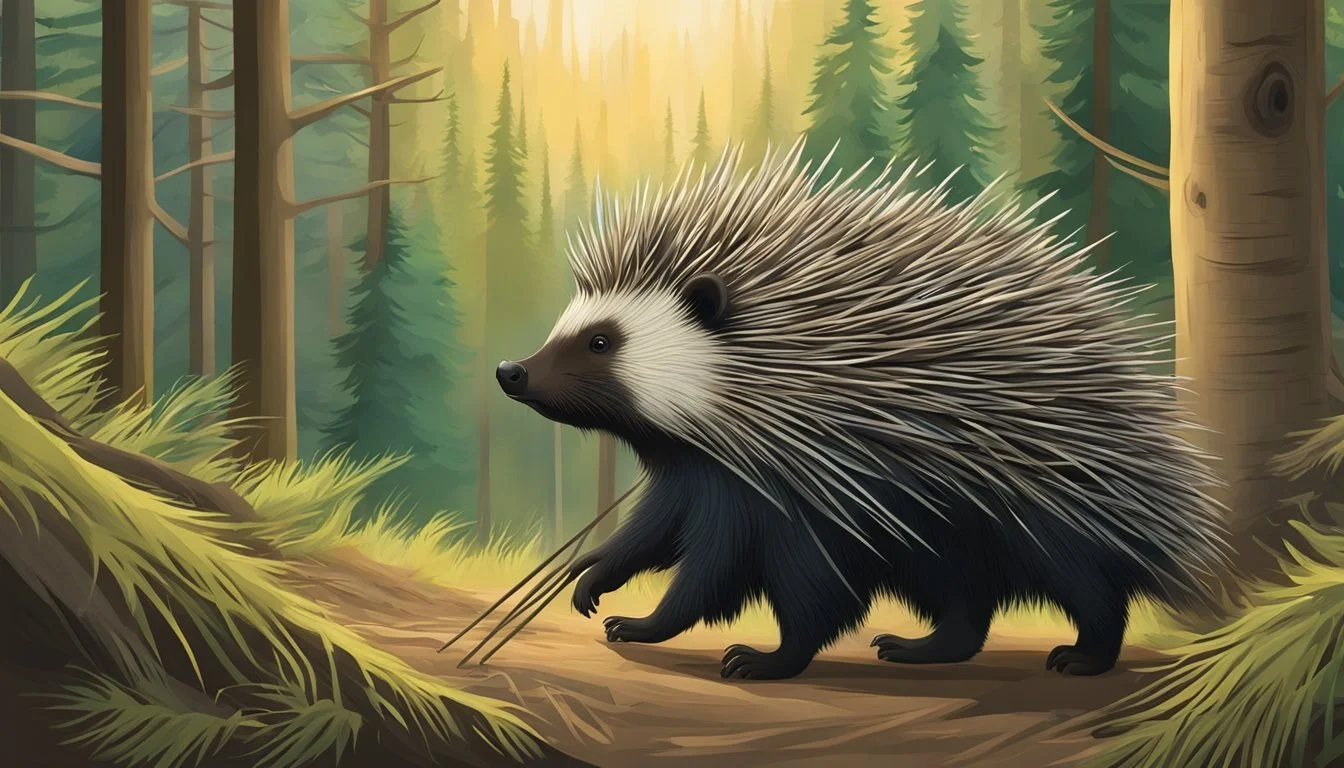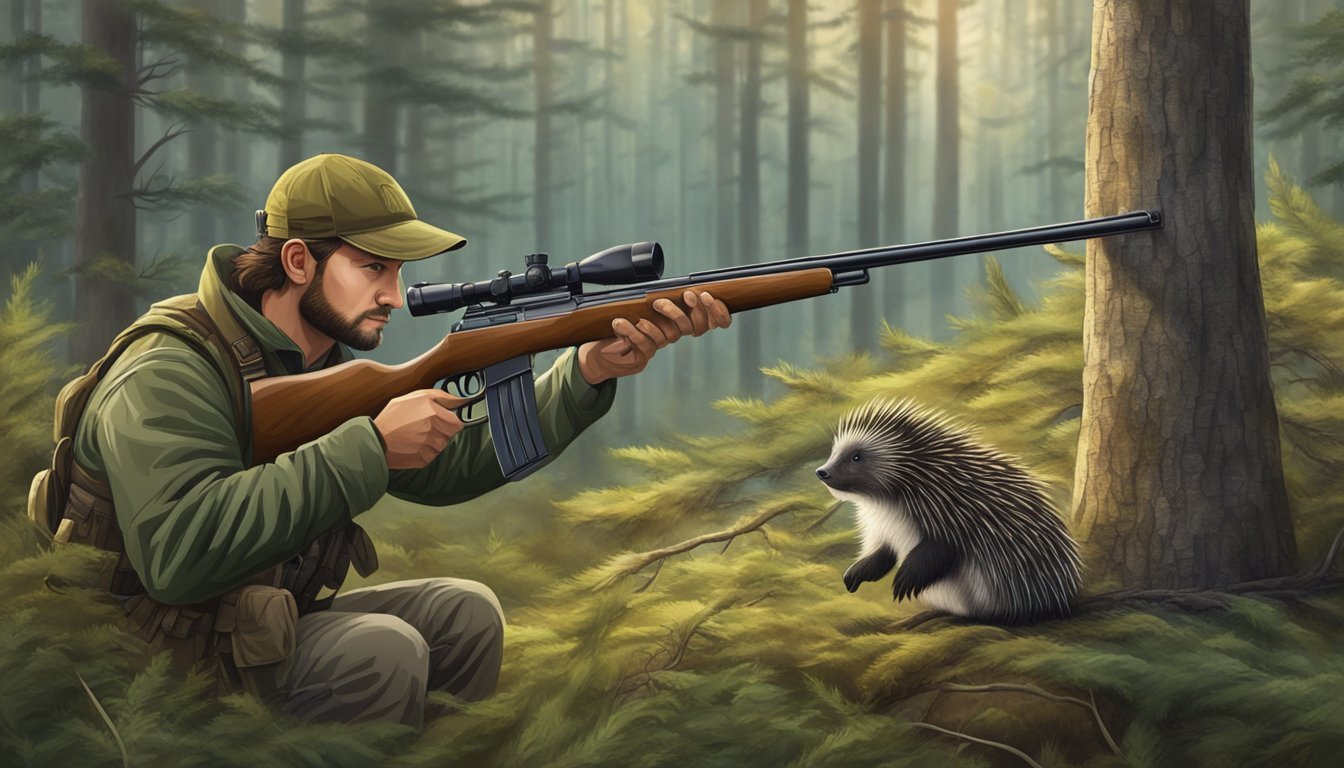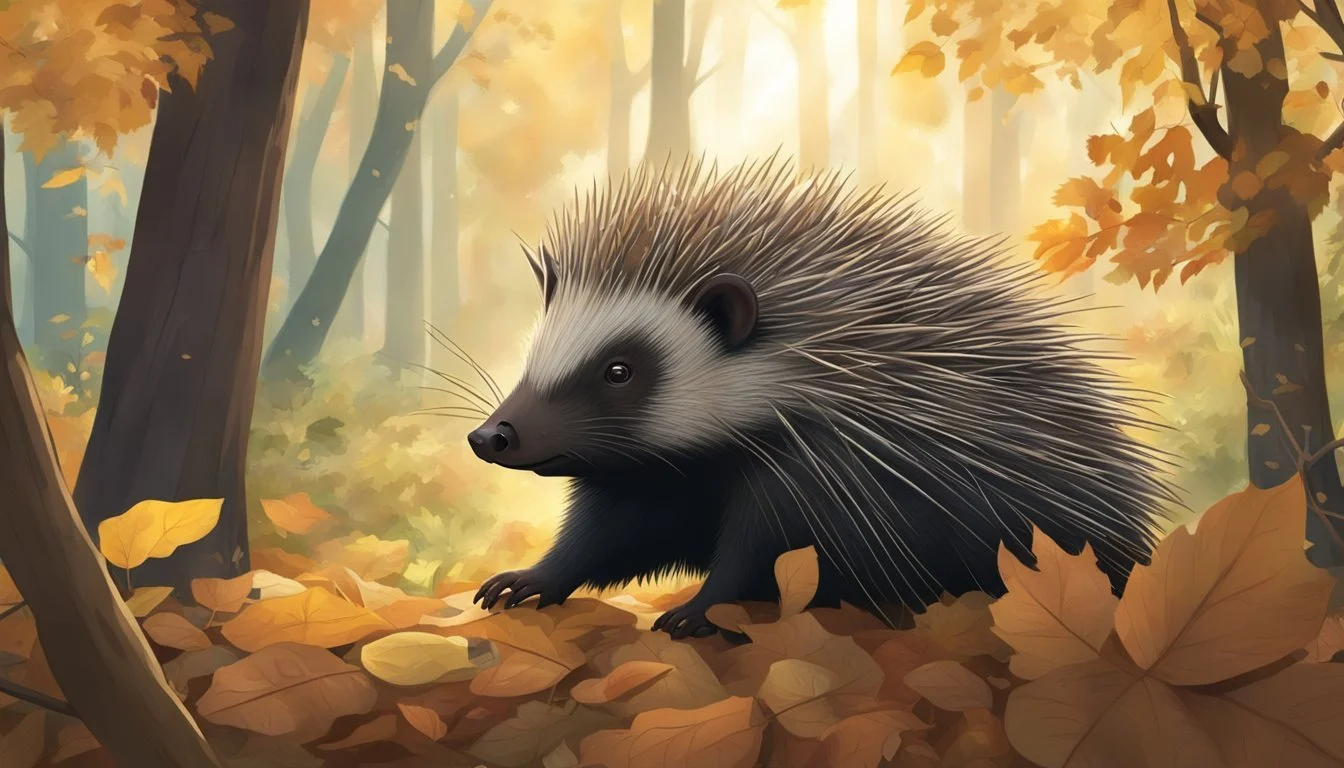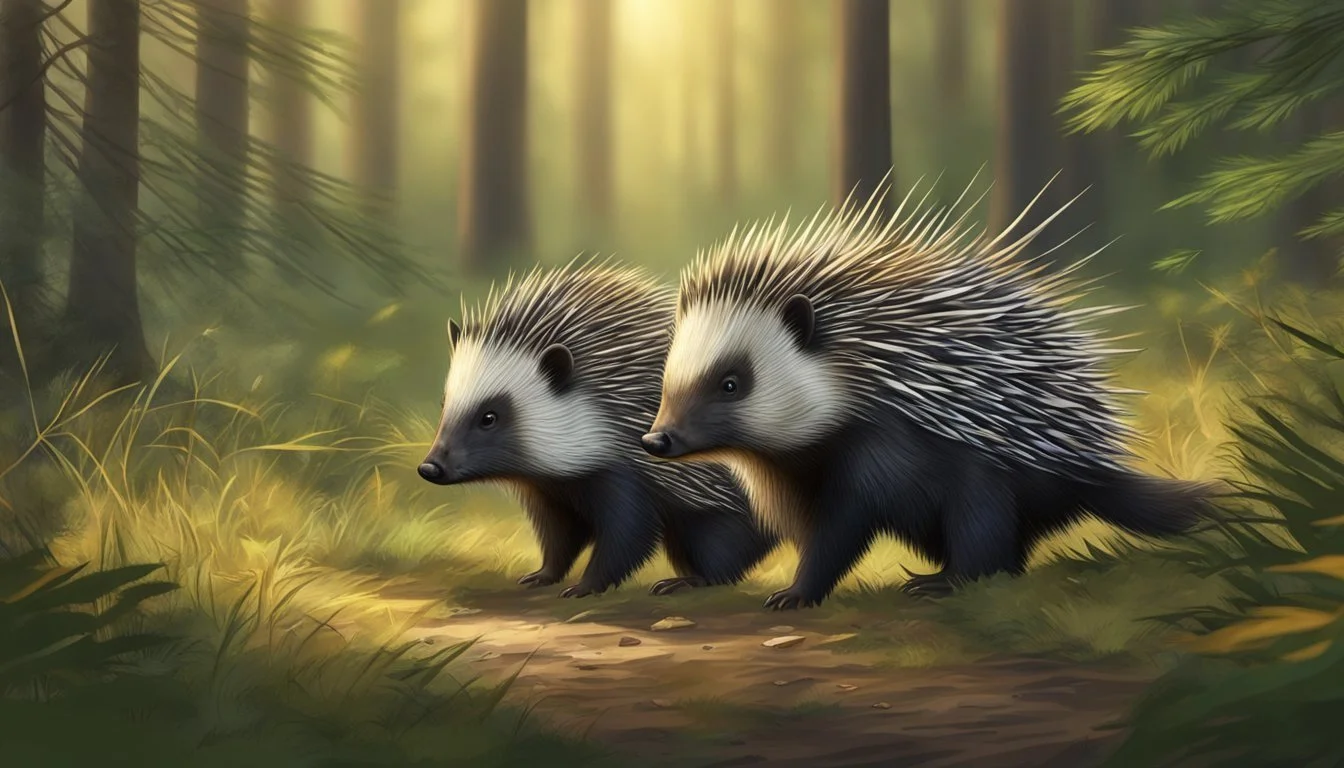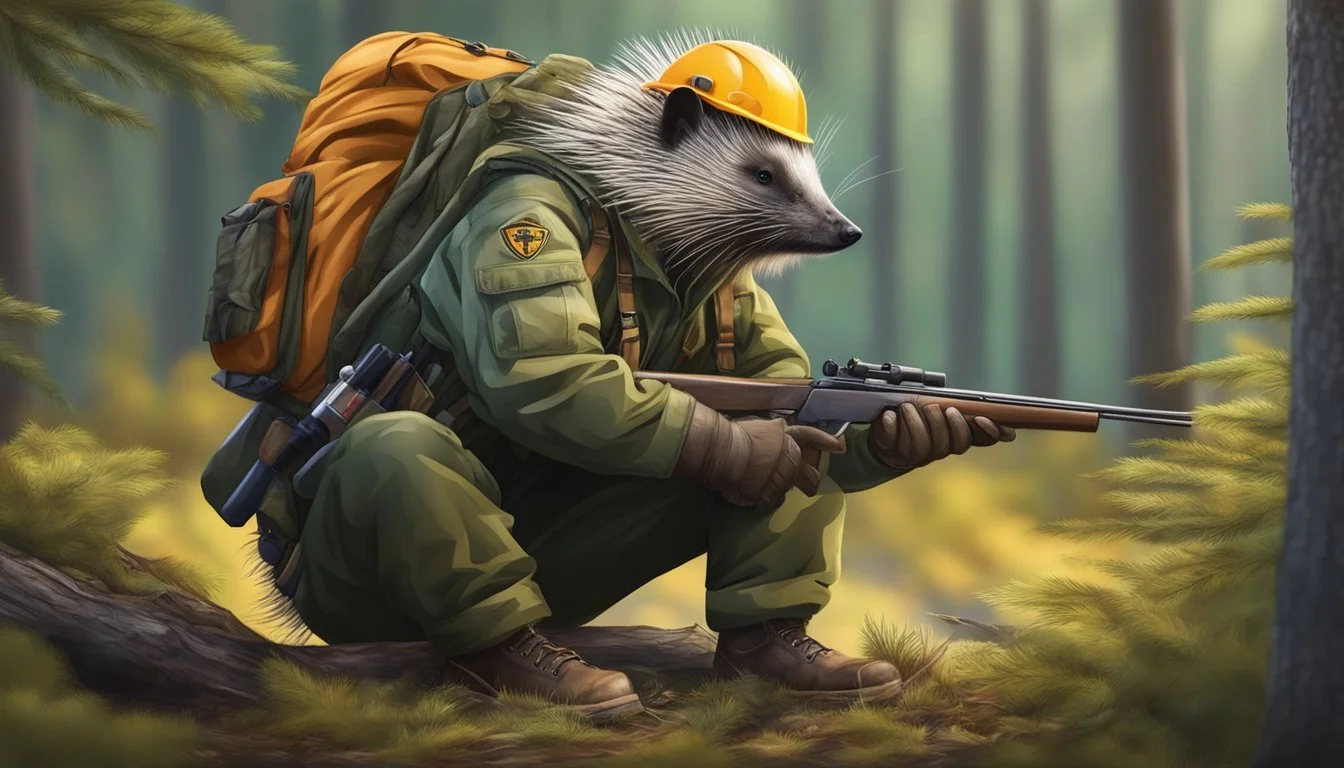Porcupine Hunting Seasons
Regulations and Timelines
This Article is Part of Our Guide on Hunting Seasons for Over 70 Common Game Species
Porcupines are herbivorous rodents recognized for their unique defense mechanism consisting of quills. These creatures are part of the ecosystem and play a role in their habitats. In some regions, they are considered game animals, subject to hunting regulations designed to manage their populations and mitigate their impact on the environment, particularly in forested areas where they can cause significant damage by feeding on tree bark.
Hunting seasons for porcupines, when established, are regulated by state wildlife agencies. These seasons are carefully determined based on various factors that may include the porcupine's reproductive cycles, population status, and their ecological impact. In states where porcupines are unprotected, they may be hunted throughout the year. However, most wildlife, including porcupines in certain areas, are protected and can only be hunted during specific periods, ensuring sustainable management and conservation.
Regulatory frameworks aim to balance the needs of wildlife with the interests of people. They make provisions for hunting methods, licensing, and sometimes exemptions based on factors such as land ownership or the hunter's age. Such measures ensure hunting practices support wildlife management goals while providing opportunities for outdoor recreation and maintaining ecological integrity.
Porcupine Identification
Identifying a porcupine correctly is crucial before hunting, focusing on its physical characteristics, habitat and range, and behavior and diet.
Physical Characteristics
Porcupines are easily recognizable rodents due to their protective quills—sharp, barbed hairs that cover their back, sides, and tail. These quills can be up to four inches long and are a key identification feature. The North American porcupine, Erethizon dorsatum, has a chunky body with a small head and short legs, and its overall length can be between 25 to 36 inches, including a tail length of 8 to 10 inches.
Habitat and Range
This rodent is adaptable to various habitats but predominantly resides in forested areas that provide an ample supply of food such as trees for bark, leaves, and twigs. Their range extends across North America, from Canada to northern Mexico, and from the West Coast to the East Coast.
Behavior and Diet
Porcupines are mostly nocturnal and spend a significant amount of time in trees. They feed on a wide array of vegetation including buds, seeds, needles of conifers, flowers, and roots. During the winter, their diet is mainly the inner bark of trees. They utilize dens found in hollow logs or rocky areas for shelter. Contrary to myth, porcupines do not shoot their quills but will defend using their tails if threatened.
Legal Aspects of Porcupine Hunting
Before engaging in porcupine hunting, hunters must be aware of the state-specific legal requirements such as obtaining necessary hunting licenses and understanding the established bag limits and season dates.
Hunting Licenses and Permits
In most states, including Pennsylvania, any individual seeking to hunt porcupines must possess a valid hunting license. This license serves as an official document permitting the holder to legally hunt wildlife, including porcupines. Licenses are often issued by wildlife or game commissions, with the Pennsylvania Game Commission being the responsible body in Pennsylvania. Additionally, permits may be required depending on the regulations of the respective state.
Hunter's age: Typically varies by state; some may require a junior license for younger hunters.
Hunter safety course: May be mandatory to secure a license.
Hunting Regulations and Seasons
The open season for hunting porcupines is not uniformly regulated across all states, and in some jurisdictions, there may not be a specific hunting season. Hunters should consult local regulations to determine if an open season has been declared. For example:
Pennsylvania: The state has sanctioned a nearly six-month hunting season for porcupines.
No specific season: In other regions, porcupines can be hunted year-round with a valid license.
It is critical that hunters adhere to state-specific hunting regulations to ensure legal compliance.
Bag Limits and Season Dates
While bag limits and season dates can vary by state, hunters must follow these guidelines strictly to support wildlife conservation efforts. In some states, there might be no explicit bag limit due to the porcupine's status as a non-game or pest species, but local wildlife management authorities may still enforce restrictions.
Season dates: Often established by wildlife authorities.
Bag limits: Can depend on the state and its assessment of porcupine populations.
For precise limits and dates, hunters are advised to refer directly to the published regulations from their state's wildlife or game commission.
Porcupine Ecology
Understanding porcupine ecology is crucial for sustainable hunting practices. It encompasses their population dynamics, interactions with predators, reproductive habits, and the strategies employed for their conservation and management.
Population and Predators
Population: Porcupines are solitary animals, widely distributed across various habitats. While specific population numbers are not uniform and can fluctuate, they are generally considered common in their range.
Predators: Predation mainly involves natural enemies such as coyotes, foxes, bobcats, and fishers. Among these, fishers are especially adept at hunting porcupines, and they play a significant role in population control.
Coyotes and foxes may prey upon porcupines but are less effective due to the porcupine's quill defense mechanism.
Bobcats will occasionally hunt porcupines, but such occurrences are relatively infrequent due to the risks involved.
Reproduction and Life Cycle
Porcupines reach sexual maturity at the age of one to two years. They tend to have a slow reproduction rate with a long gestation period for a rodent, lasting around 202 days.
After the gestation period, typically one offspring is born.
They exhibit a simple reproductive cycle with births peaking in the spring season.
Conservation and Management
Conservation: The porcupine's stable population does not currently require intensive conservation efforts. However, they are monitored to ensure populations remain healthy.
Management: Hunting seasons are regulated to balance human needs with wildlife conservation. Methods for managing porcupine populations include:
Implementing and enforcing hunting regulations.
Habitat management to maintain the natural balance between porcupines and their predators.
Hunting Techniques
Successful porcupine hunting requires a solid understanding of preparation, tracking, and adherence to ethical standards. This section provides focused insights into the crucial aspects of equipping oneself, identifying porcupine presence in the wild, and conducting the hunt in a responsible manner.
Preparation and Gear
Before setting out, hunters must ensure they have the appropriate license and are familiar with the hunting season regulations. Gear selection is critical, with small-caliber rifles or shotguns being the preferred firearms for a humane kill. Additionally, hunters should carry:
A bright headlamp or flashlight for nocturnal tracking.
Protective clothing to defend against quills during handling.
Tracking and Signs
Porcupines are nocturnal, and signs of their presence include:
Gnawed tree bark, as they have an appetite for bark and salt.
Quill droppings around trees.
Salt licks, which attract porcupines due to their dietary needs.
Tracking techniques involve searching for these signs at dusk or dawn when porcupines are more active.
Ethical Hunting Practices
Hunters should respect the animal and the environment:
Only take shots that ensure a quick and humane dispatch.
Avoid wasteful practices by utilizing as much of the animal as possible.
Understanding these techniques will not only enhance the experience but ensure the sustainability and respect for wildlife.
Related Wildlife Interactions
In the context of porcupine hunting seasons, wildlife interactions play an integral role in understanding the dynamics of various species within their habitats. It's important to examine the competitive relationships among species, identify natural predators of porcupines, and explore the nuances of human-wildlife conflict.
Competing Species
Porcupines often compete for resources with other herbivores within their ecosystems. Key competitors include:
Deer: Especially in regions like Pennsylvania, both porcupines and deer vie for similar foliage, sometimes leading to interspecific aggressions.
Rodents: Smaller rodents may compete for some of the same plant materials, although the impact on porcupine populations is generally minimal due to the larger size and defenses of porcupines.
Porcupine Predators
Several carnivores are known to prey on porcupines, despite their quilled defenses. Notable predators include:
Fishers: Adapted predators known for their ability to prey on porcupines by targeting their non-quilled underbellies.
Coyotes, bobcats, and foxes: These predators occasionally hunt porcupines but often choose easier prey due to the risks involved.
Owls and eagles: Birds of prey may sometimes attack younger or smaller porcupines.
Human-Wildlife Conflict
Interactions between porcupines and humans can lead to conflict, particularly when porcupines encroach on human habitats or agricultural areas. Factors include:
Property damage: Porcupines may gnaw on wooden structures or invade yards in search of salt.
Vehicle collisions: An increase in road construction through porcupine habitats has resulted in more frequent collisions.
Hunting pressure: In areas with regulated porcupine hunting seasons, there is a balance to be maintained between population control and conservation.
Regional Variations in Porcupine Hunting
Hunting regulations for porcupines vary by location across North America, reflecting the animal's differing populations and ecological impacts.
North American Porcupine Range
The North American porcupine occupies a wide range across the continent. Its habitat extends from the Arctic tundra of Alaska and Canada down through the northern United States, including states like Minnesota and Pennsylvania. The animal is well adapted to many environments, from dense forests to open tundra.
Alaska and Canada: Porcupines are a common sight, and hunting seasons are generally less restrictive due to their ample numbers.
Northern United States: Includes states such as Minnesota, where porcupines are also present but may have more structured seasons to balance ecological impact.
State-Specific Regulations
Each state has its own approach to wildlife management, including porcupine hunting.
Pennsylvania:
Season: Nearly six-month hunting season approved by the Pennsylvania Game Commission.
Regulation rationale: Aimed at managing the porcupine population, which is considered pestilent in some areas due to their appetite for tree bark.
Minnesota:
Porcupines can be hunted, but regulations are in place to ensure sustainability and protect habitats.
Table 1: Porcupine Hunting Seasons in Selected States
State Season Duration Restrictions Alaska Year-round Few, if any Canada Year-round Few, but vary by province Pennsylvania Approximately 6 months As determined by the Pennsylvania Game Commission Minnesota Specific seasons Sustainability focused
It is critical for hunters to check the latest regulations with their state's wildlife agency or game commission before hunting, as rules may change to reflect current conservation needs and research.
Utilization of Porcupine
Porcupines are utilized in various ways, primarily in culinary practices and for their pelts which hold value in craft making. Both uses are subject to regulations to ensure sustainable practices.
Culinary Uses
Porcupines are hunted for their meat, which is consumed in certain regions. The hunter must adhere to all local and state hunting regulations, ensuring the season is open and they possess the proper permits. In preparing porcupine as a dish, it is important to handle the animal with care, particularly due to the presence of sharp quills.
Craft and Pelt Use
The pelt of a porcupine is a valued commodity, especially for its unique quills. The quills, or barbs, are traditionally used in craftmaking and are carefully harvested from the animal—typically after ensuring the porcupine is no longer alive—to avoid the risk of injury.
Handling Quills: Care is necessary when removing quills to prevent injury. Gloves and tools are often used for safe removal.
Regulations on Pelt: Legal frameworks dictate the pelt harvest to support conservation.
Crafts: Quills are incorporated into various items, from jewelry to decorations. Their distinctive look and texture contribute to the cultural and aesthetic value of the crafts they are used in.
Safety and First Aid
When engaging in porcupine hunting, safety and efficient first-aid for quill-related injuries are crucial. The focus is both on prevention and immediate response in the event of an encounter with porcupine quills.
Quill Extraction and Treatment
In the unfortunate event that a hunter or a hunting dog becomes impaled with porcupine quills, knowing proper quill extraction and treatment is vital. Quills should be removed as promptly as possible to prevent them from migrating further into tissue. The extraction process involves:
Grasping the quill close to the entry point with tweezers.
Pulling straight out smoothly to avoid breaking the quill.
Once removed, it's important to clean the affected area with soap and water and to apply an antiseptic. If quills have penetrated deeply or are near sensitive areas, seeking professional medical or veterinary assistance is imperative.
Precautions During Hunting
Hunters must take several precautions to ensure safety during the porcupine hunting season:
Wear protective clothing. Long sleeves and gloves may provide a barrier against quills.
Train hunting dogs. Dogs should be trained to avoid porcupines or to alert the hunter rather than attacking.
Be aware of surroundings. Porcupines may climb trees; hunters should look up as well as around.
Carry a first-aid kit. Essential for any quick response to quill injuries.
By adhering to these safety measures and understanding first-aid practices, hunters can minimize the risks associated with porcupine hunting.

